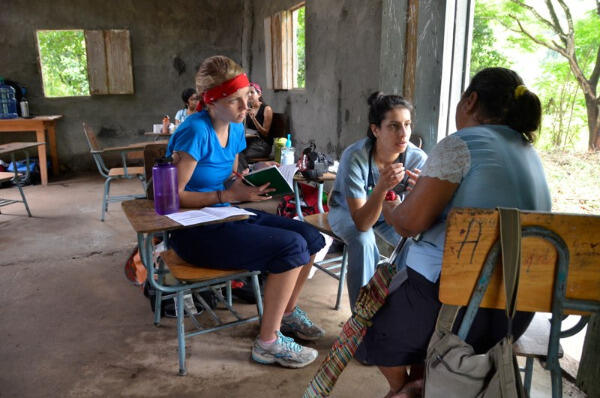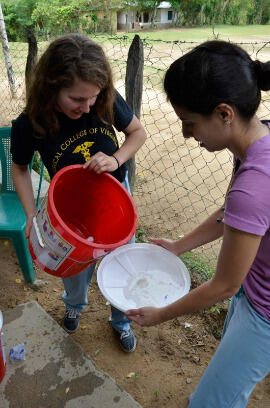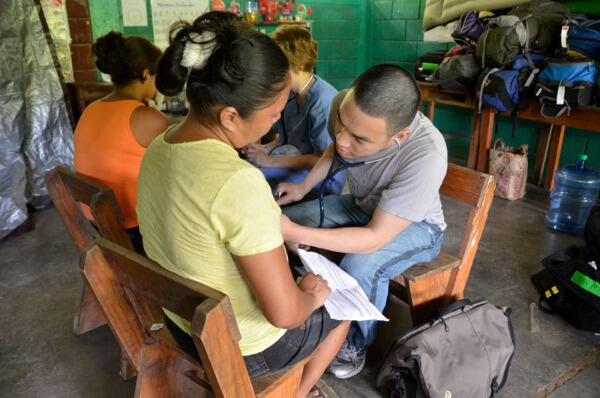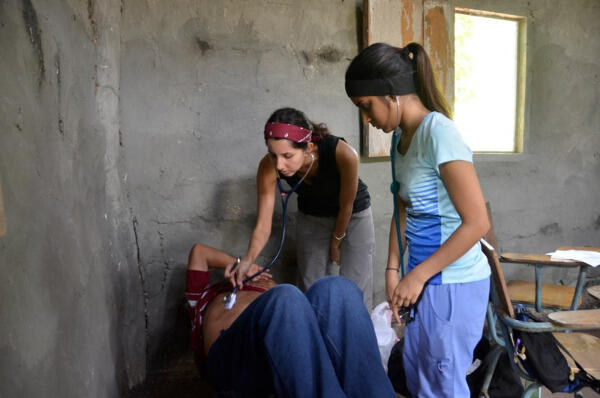
Sept. 3, 2013
Healing in Honduras
Share this story
Kate Pearson slept under a mosquito net on a cot in a three-room school-turned-medical-clinic for a week this summer. There was no electricity, no indoor bathroom, no running potable water and an outdoor spigot that only provided non-potable water … sometimes.

And she loved it; it was inspiring.
Inspiring, she said, because some people walked five to six hours to seek medical attention at the clinic where she was working and sleeping.
Inspiring because that clinic provided medical services – most of which are usually taken for granted here in the U.S. – to people who make yearly trips to the temporary clinic.
Inspiring because her group from Virginia Commonwealth University was saving lives.
Pearson, now a fourth-year medical student in the VCU School of Medicine, was working with the Global Health and Health Disparities Program (GH2DP), affiliated with HOMBRE, a nonprofit through which VCU students and faculty provide health care around the world.
Each year since 2008, GH2DP has traveled to northern Honduras to improve the health of 2,000 residents across 17 villages, to introduce medical students to global health issues and to conduct global health research.
In addition to the clinic that provides direct medical care such as hypertension, anemia and diabetes screening, pap smears, worm treatments and general medial consultations,GH2DP distributes water filters to help reduce cases of diarrhea and dysentery.
“Kids were dying of diarrheal illness up in the mountains where we go, if you can believe that in this day and age,” said Michael Stevens, M.D., assistant professor of medicine and Global Health Pathway Director for the Internal Medicine Residency Program at the VCU School of Medicine. “But in the last 18 months no kids have died from diarrhea, and we attribute a lot of those gains to the water filter program.”

This summer was the sixth consecutive year GH2DP held large-scale medical clinics in the region. In that time the group has had more than 5,700 direct patient encounters and distributed more than 400 water filters, each of which provides clean drinking water to an entire familyfor more than two years. Stevens says data from the local Ministry of Health shows instances of diarrhea and dysentery have halved in the 17 villages served by GH2DP since the water filter program began.
These cumulative results are what Stevens hopes will inspire students to come back year after year and to continue this type of work elsewhere in the future.
“Many people go into the health field because they want to help people, and when you are seeing very basic needs not met - like access to clean water and sanitation - you can see firsthand what those health pressures do to people’s well-being,” he said. “That can have an enormous impact on a learner in terms of wanting to contribute positively to people who are disenfranchised or don’t have access to basic health needs, and they can bring those lessons back to the U.S. where it’s a little less obvious but no less important to recognize health disparities.”
This year’s group of students included five rising second-year medical students, two rising fourth-year medical students and two pharmacy students, all from VCU. Additionally, three internal medicine residents, two pediatric residents, one pediatric fellow, two nurses, three attending physicians and one Ph.D. microbiologist made the trip.
The other two physicians besides Stevens were Gonzalo Bearman, M.D., professor of medicine, VCU School of Medicine, and Patrick Mason, M.D., a pediatric endocrinologist at Inova Fairfax Hospital for Children, both of whom have been involved in GH2DP from the beginning.

This was Pearson’s second trip to Honduras with GH2DP. She is one of the students who just couldn’t stay away.
“I was impacted the first time I went just by seeing the incredible heath care needs of this community,” she said. “And the work that Drs. Bearman, Mason and Stevens do well is to improve the mission every single year to be better tailored to the community each year they come back, and that’s what made me want to be a part of it is seeing that evolution.”
Stevens said that evolution is vital to the mission.
“There are a lot of dangers to short-term medical relief trips,” he said. “You go in, you don’t have a major impact because you’re not well integrated with the community, and the long-term benefit of that kind of work is questionable.
“It took a long time for us to get to a point where we had relationships with the communities and we were really affecting some longitudinal positive good, but I think at this point we are having a very positive effect on the communities we’re serving.”
Stevens was integral in creating the GH2DP program, having previously participated on a relief trip in Honduras as a medicine resident and later as a chief resident. His passion was sparked largely by a 2001 trip when he was a student in the VCU School of Medicine. He and other students organized their own trip to Kenya and brought along then-faculty member Tom Kerkering, M.D.
“The experiences I had seeing disease firsthand in that context where people really had enormous health pressures, weren’t having basic health needs met and then the impact we could have on them really got me fired up about global health,” he said.
He hopes to see GH2DP students have the same experience.
“The idea is that those passions which allowed them to get excited about going into medicine in the first place will ignite something in their careers to help address health disparities and contribute positively to combating health pressures that affect at-risk populations.”
So far, it appears the plan is working.
This has shaped my medical education more than anything I’ve done here, and I think it will shape the type of doctor I will be.
“[GH2DP] has been so inspiring for me because in medical school so much of the first two years is book work and memorization, and the goals that you had when you set out to be a doctor can feel very abstract at times when you’re sitting in the library for long hours,” Pearson said. “This has shaped my medical education more than anything I’ve done here, and I think it will shape the type of doctor I will be. I think it will shape my choice to continue to do research and public health work in the future. I think a big reason is because it is so inspiring to work with Dr. Stevens, Dr. Bearman and Dr. Mason who are all so invested in committing long term.”
Subscribe for free to the weekly VCU News email newsletter at http://newsletter.news.vcu.
Subscribe to VCU News
Subscribe to VCU News at newsletter.vcu.edu and receive a selection of stories, videos, photos, news clips and event listings in your inbox.







